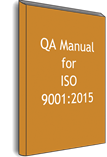Theory Of Constraints
Dr. Eli Goldratt started the theory of constraints (TOC). He based this management theory that every system has at least one constraint limiting it from getting more of what it strives for. If this were not true, then the system would produce infinite output.
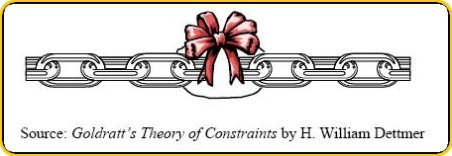
These constraints determine the output of a system whether they are acknowledged or not. Therefore, it is in a manager's best interest to identify and reduce the system constraints within the organization.
The theory of constraints is both descriptive and prescriptive in nature; it not only describes the cause of system constraints, but also provides guidance on how to resolve them. This page only provides an overview of both. We begin with a discussion of some key underlying concepts:
- Systems as chains
- Throughput, inventory, and operating expense (T, I, OE)
TrainingKeeper Software. Keep, organize and plan all your employees' training and activities. Software includes multi-user support with reports, certs, and calendars.
Systems As Chains
A system is a collection of interrelated, independent processes that work together to turn inputs into outputs in the pursuit of some goal.
As pictured above, a chain always has one weakest link. If one applies force to the chain at an increasing rate, it would eventually break at the weakest link.
Therefore, the weakest link is the constraint that prevents the system (chain) from doing any better at achieving its goal (accepting force).
Goldratt states that at any given time there is only one constraint in a system that limits the output of the entire system. The remaining links are known as nonconstraints.
After strengthening one constraint, the system is stronger. However, the system does not become infinitely stronger. The constraint simply migrates to a different component of the system. Some other link is now the weakest and all the other links are nonconstraints.
An Example
To better understand the theory of constraints and nonconstraints, consider a production system that runs raw materials through three component processes and then turns them into a finished product.

Within this system, each process is equivalent to a link in the production chain. Where is the constraint in this chain? Process B is the weakest link. Process B produces the least at only six units per day . Process A and C are the nonconstraints.
Imagine that the manufacturer improves process B until it can produce 18 units per day. Now, process C becomes the system constraint while the nonconstraints are everywhere else. If process improvements continue until all processes are producing 18 units/day or higher, the system constraint becomes the marketplace, which can accept only 15 units per day.
Get certified in Risk Management through our completely on-line training system. Study at your own pace.
At this point, internal constraints have been replaced by an external constraint. Overall, the theory of constraints emphasizes fixing the weakest link in the chainthe system constraintand temporarily ignoring the nonconstraints. In this way, the theory has a profound impact on process improvement.
Rather than spreading limited time, energy, and resources across an entire system (which may or may not result in tangible results), teams focus on that part of the system with the potential to produce immediate system improvement.
Throughput, Inventory, And Operating Expense
In order to determine the effect that any local action has on progress toward a system goal, Goldratt created a simple relationship chart between three system-level measurements: throughput (T), inventory (I), and operating expense (OE).
In order to determine the effect that any local action has on progress toward a system goal, Goldratt created a simple relationship chart between three system-level measurements: throughput (T), inventory (I), and operating expense (OE).
8D Manager Software with 8D, 9D, 5Y and 4M report generator. Your corrective action software for managing, measuring, and reporting issues.

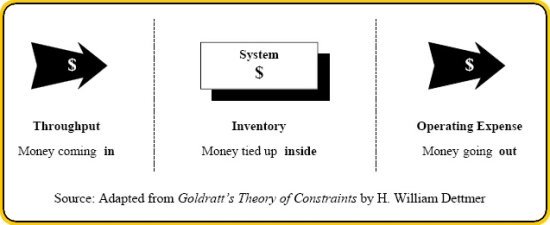
Given Goldratt's three dimensions, organizations have three different options for system improvement: increasing T, reducing I, or reducing OE.
The practical limits of reducing inventory and operating expenses are relatively low, as a system can't produce many outputs without them. Theoretically, there's no upper limit to how much an organization can increase its throughput, but market sizes are limited.
The potential for increasing T tend to be much higher than the potential for decreasing I and OE. Therefore, a basic model for system improvements focuses on increasing T and making reduction of I and OE a secondary priority, as shown below

Snap Sampling Plans! software combines all the key industry standard attribute sampling plans into one place.
With over 10,000 sampling possibilities, Snap Sampling Plans! guides you in selecting the correct AQL sampling plan.
Basic Principles of Theory of Constraints
Goldratt outlines several principles that help creates an environment conductive to the prescriptive part of his theory of constraints. The prescriptive part of the theory of constraints helps organizations answer three management questions regarding systems and their constraints:
- Where is the constraint?
- What should we do with the constraint?
- How do we implement the change?
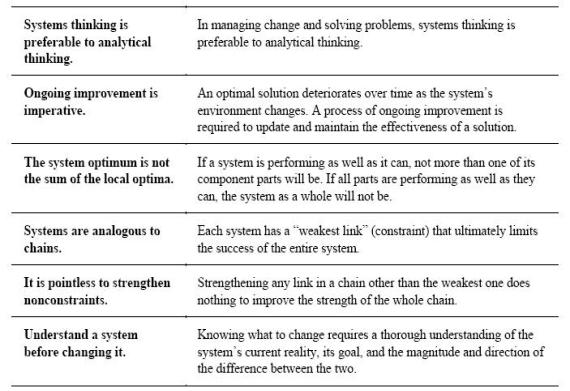

8D Manager Software with 8D, 9D, 5Y and 4M report generator. Your corrective action software for managing, measuring, and reporting issues.
The Five Focusing Steps
Step 1: Identify the system constraint. In the first step, an organization identifies the part of the system that constitutes the weakest link. Then determine whether it is a physical constraint or a policy-related issue.
Step 2: Decide how to exploit the constraint. Organizations exploit the constraint by utilizing every bit of the constraining component without committing to potentially expensive changes and/or upgrades.
Step 3: Subordinate everything else. With a plan in place for exploiting the constraint, the organization adjusts the rest of the system to enable the constraint to operate at maximum effectiveness.
Evaluate the results to see if the constraint still holds back system performance. If it is, the organization proceeds to Step 4. It not, the constraint has been eliminated and the organization skips ahead to Step 5.
Step 4: Elevate the constraint. If an organization reaches Step 4, it means that Steps 2 and 3 were not sufficient in eliminating the constraint. At this point, the organization elevates the constraint by taking whatever action needed to eliminate it.
This may involve major changes to the existing system, such as reorganization, divestiture, or capital improvements. Since these typically require a substantial up-front investment, the organization should be certain that the constraint cannot be improved from Steps 1 through 3.
Step 5: Go back to Step 1. After a constraint is broken, the organization repeats the steps all over again, looking for the next thing constraining link. At the same time, the organization needs to monitor how the changes related to subsequent constraints impact the already improved constraints.
Your comprehensive package for learning and training the TRIZ problem solving methodology. Includes mobile app, books, PowerPoints and real world examples.
The Five Logical Tools
1) Current reality tree (CRT). Helps organizations work backward from an undesirable effect to identify the core problem.
2) Conflict resolution diagram (CRD). Allows organizations to resolve hidden conflicts that usually perpetuate chronic problems (also known as the evaporating cloud)
3) Future reality tree (FRT). Enables organizations verifies an action produces the desired results. It also identifies and removes any unfavorable new consequences from the action.
4) Prerequisite tree (PRT). Helps organizations implement a decision by providing a recommended sequence of events and identifying potential obstacles.
5) Transition tree (TT). Provides organizations with a detailed, step-by-step action plan for implementing a decision
In practice, the five logic trees can be used individually or together as an integrated thinking process. The table below shows how the five tools can be used together in answering the three management questions about change.

Theory of Constraints is an important theory behind lean manufacturing
|
Quality Assurance Solutions Robert Broughton (805) 419-3344 USA |
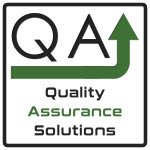 |
|
Software, Videos, Manuals, On-Line Certifications | ||
|
450+ Editable Slides with support links | ||
|
Corrective Action Software | ||
|
Plan and Track Training | ||
|
AQL Inspection Software |
|
Learn and Train TRIZ | ||
|
Editable Template | ||
|
Templates, Guides, QA Manual, Audit Checklists | ||
|
EMS Manual, Procedures, Forms, Examples, Audits, Videos | ||
|
On-Line Accredited Certifications Six Sigma, Risk Management, SCRUM | ||
|
Software, Videos, Manuals, On-Line Certifications |






























